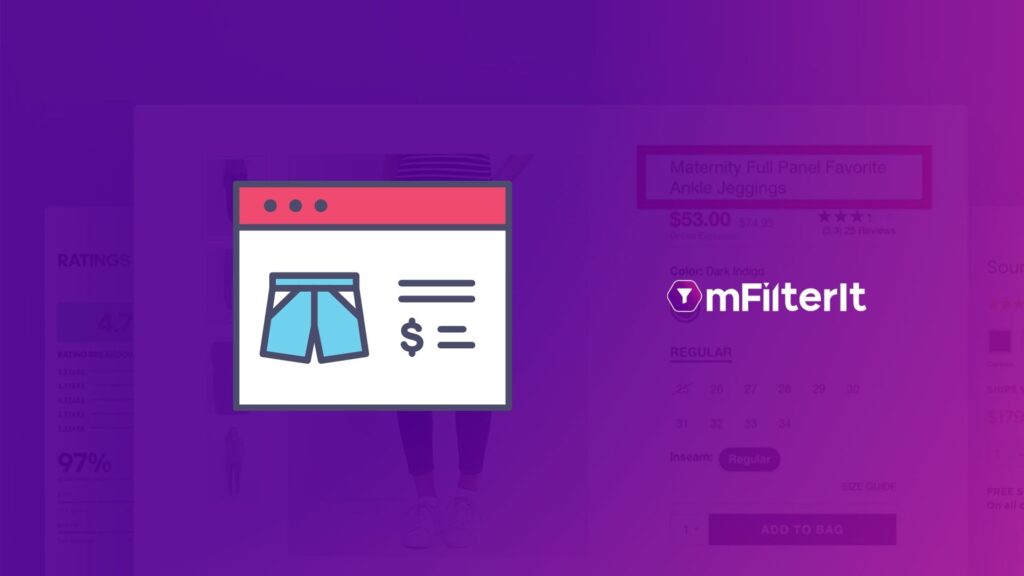A product title is the second-most visible aspect after viewing the item’s image on any search engine. 57% of online shoppers use search engines like Google, etc., to find more about a product. Another report states that relevant keywords in the title tag help in good SERP 4.39 out of 5.0 times.
Creating a compelling title is a priority for eCom brands as it can directly impact their traffic reach, discoverability, and sales. An SEO-friendly title must have the relevant product information created using targeted keywords and confine within the perfect page character limitations while connecting with the target audience’s needs.
Simultaneously, brands need to avoid words like sale, offer, promotion, best seller, etc., while creating the product titles. Achieving these aspects also helps brands enhance user experience, generate interest among new buyers, and manage buyer expectations. So, while most people would say, ‘what’s in a name/title?’ we would like to answer this question for you while offering a checklist. So, let’s get onto it.
Why Do eCom Marketers Make a Fuss About Product Titles?
The average customer visit duration on Amazon is 13 minutes and 11 seconds, stating the average time brands have to convince viewers to become potential buyers. Comparing the visit duration with the 2020 conversion rate by the end of the third quarter, i.e., 2.17%, would mean brands have an average of 2.17% conversion in 13.11 minutes, which likely involves searches and navigation. Given these facts, optimizing product titles and offering a suitable image for ease in product recognition becomes vital besides pricing intelligence and delivery duration.
Moreover, suppose you carefully view Amazon’s mobile and webstore. In that case, you will find that the app has a limitation of 79 characters, whereas the website displays no more than 200 characters in the title. However, the limitations can vary based upon the eCom store, categories, and seller/vendor. Marketers want their product features/capabilities to get covered as USPs in the title; however, they often fail in the title score if analyzed carefully. Here is a classic example of characters exceeding the title limit on a laptop:
Most SEO experts would ideally identify that the length could decrease and optimize the title by removing either one of the targeted keywords (Smart Watch Smartwatch or Smart Watches for Men). It would also offer an advantage of showing more about the product features.
What Makes a Great Product Title?
Making a compelling title jots down to length, word placements, and keywords. However, a few facts need to be kept in mind while focusing on these three aspects. Let’s get onto them.
- Keywords: One of the most influential factors that prompt consumers towards further product exploration on search engines of websites like Google and eCom stores like Amazon, Big Basket, and Flipkart is ‘Keywords.’ Given the average duration, incorporating the right keywords, in the beginning, is always a priority; however, so is avoiding keyword stuffing. Brands don’t want their customers to think that the product looks unworthy of their basket and requires spending more time on the title. The weight of keywords is equal on an entire product page but begins with the title.
- Word Placement: After deciding on the relevant content of the product, the next step is deciding on word placements or structure. eCom marketplaces have guidelines for helping sellers with product titles, descriptions, and A+ content, yet most sellers score low results in all three aspects. For example, your title could include “Brand name, sub-brand, product, feature, etc. Let’s take the example from the above image,” Noise ColorFit Pulse Spo2 Smart Watch with 10 days battery life….” The keyword is placed after the fourth word when it could easily get placed before “Spo2” and grab higher views even on the mobile app.
- Length: Although we have already covered this aspect, let’s get more specific. According to a source, the average character length for product titles across most eCom stores is 50-200. The length is decided based on many factors, but one of them is that the customers have a low retention span while searching for online products (which we have already covered). Therefore, short titles often generate the interest of the buyers. Here is a classic example of the keyword ‘laptop backpack’:
In this example, the brand fails in the word placement but would score high in length and keyword, as it has a good product description in the title, which is also clearly visible on the mobile app.
The Best Method to Ensure Great Product Titles
Knowing the title, content, review, and overall score helps brands to make changes in their ongoing content and marketing practices across eCom stores. The best method to continuously review these four scores is eCom Competitive Analytics or mScanIt. The technology-driven solution offers insights for improving the perfect page summary scores across eCom platforms while offering a comparative score review of the competitors.
Final Words
Brands can only decide whether their product title on eCom stores is more compelling than the competitors by continuously reviewing them through eCom Competitive Analytics. The solution also offers scores for other aspects necessary for creating a perfect page.
mScanIt, powered by mFilterIt, is currently being used by major eCom industry leaders across borders and allows brands to learn more about their product listings through in-depth insights.
For more information on the advantages of mScanIt for your business, connect with us by dropping a comment or scheduling a demo.



